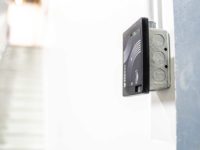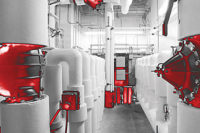Think Green In Everything You Do
Tom Hartman, internationally recognized expert in the field of advanced, high-performance building operation strategies, prepared an article called "Designing Greener Buildings." The article is online at www.automatedbuildings.com/news/nov00/ articles/hrtmn/hrtmn.htm.This article provides us with a shopping list of necessities for greener buildings. A few direct quotes from Tom's article are important to set the scene.
"Think green in all your work: For my presentation, I showed the group how applying integrated network control concepts can reduce hvac energy use by 30% to 50% below the energy requirements for the same equipment with the types of conventional controls that are currently employed. I also discussed the unfortunate fact that at times technology is seen as an enemy of green building designs. This view may be fostered by the narrow focus engineers too often apply that results in 'brute force' comfort system designs."
The paragraph ends with "Broadening our thinking to a 'green' perspective helps us do a better job in all the areas of our responsibility."
Amen, Tom! Opportunities are evolving daily to use building automation intelligently and not simply as a connector of the myriad of "brute force" comfort systems. To achieve this renaissance, the building automation industry must become the leaders on future green teams and show how improving building intelligence with well-integrated automation can enhance the new style, low-tech buildings.
We can bring passive designs alive with the necessary ingredient "intelligent interaction." Rapid automation evolution will occur with these new hybrid green buildings. The low energy impact of the original raw materials, coupled with the potential power of automation, creates the greenest of all building materials.
Automation's ability to provide mammoth changes to buildings with only grams of substance, and the ability to be easily reconfigured to grow and adapt with the building makes it the essential backbone of leading green building design.
Building Automation Technology Grows
I was pleased to assist with the building automation system section of an extremely useful website at www.advancedbuildings.org. This noncommercial site is a valuable resource of information for the industry that builds green buildings. It contains over 60 technologies that can greatly improve building energy performance and lower the total environmental impact of buildings.As well as being a column writer, editor, and automation consultant, I also provide energy conservation consulting, primarily for large, existing buildings.
The cost to retrofit many of these technologies once the building is built is prohibitive; the cost to include the concepts in the original design provides the lowest lifecycle cost. Very few good examples exist of what could be achieved with the ultimate integration of building intelligence and green buildings. Another article on our website submitted from Denmark and based on an Austrian project on "intelligent sun protection system" from LonWorks technology shows how we can do a better job interfacing with the total building fenestration and envelope.
The interaction of buildings with occupants has been very limited because the automation systems had no knowledge of when occupants were in various areas, who the occupants were, and what they were doing. Passive security devices have become the bar codes on our bodies that changed this. Integrating this powerful technology with lighting, ventilation, and other environmental control functions has a powerful greening effect on most buildings. These are conventional concepts. Use your imagination to help the green team achieve what has never been done before.
The acceptance of many new communication and automation concepts has radically changed the function of our large commercial buildings. Office hotelling has allowed the sharing of expensive office buildings with an increased number of telecommunicating occupants. To effectively manage this phenomenon, coordination of everything is required, such as phones, workstations, data links, security access, etc. Occupants also must have the ability to interact virtually. The greenest of buildings extends beyond sharing office space; it includes sharing the total transportation and support infrastructures while making home units more efficient.
The above adds credence to Hartman's quote: "Broadening our thinking to a 'green' perspective helps us do a better job in all the areas of our responsibility." ES





